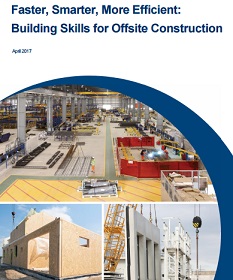Building Skills for Offsite Construction
On 13 April 2017, the Construction Industry Training Board (CITB) published a report claiming new skills are the key to success for offsite construction.
The report, ‘Faster, Smarter, More Efficient: Building Skills for Offsite Construction’, says offsite construction could revolutionise the industry and provide a solution to the UK’s housing crisis, but only if the right skills are in place.
Despite offsite construction currently accounting for just 10% of the industry’s output, the report highlights findings that 42% of construction employers with more than 100 staff expect to use offsite methods in the next 5 years. 100% said they expected an increase in the use of precast concrete panels, and 91% expected an increase in the use of precast concrete frames.
In addition, nearly 50% of construction industry clients are expecting an increase in the use of offsite construction in the next 5 years.
The report follows the recommendations set out in Mark Farmer’s ‘Modernise or Die’ published in 2016 and challenging CITB to reform their practices.
Six key skills areas related to offsite construction methods are outlined by the report:
- Digital design.
- Estimating/commercial.
- Offsite manufacturing.
- Logistics.
- Site management and integration.
- Onsite placement and assembly.
The report identifies significant barriers which prevent the delivery of training and skills in these crucial areas. These include a lack of awareness and suitability of available training and qualifications, and a shortage of qualified training providers and assessors.
CITB recommend the following actions:
- Lead a review of National Occupation Standards (NOS) in partnership with employers.
- Apply standards to a construction context, supporting key offsite functions.
- Develop a competency framework for offsite construction through working with industry.
- Promote career opportunities in offsite.
- Work alongside bodies such as the Construction Leadership Council (CLC) to create ‘centres of excellence’ for skills and knowledge.
- Work with industry to develop new qualification units and stand-alone knowledge courses.
- Fund industry experts to encourage the uptake of standardised courses.
Mark Farmer, the author of ‘Modernise or Die’ said:
“This report comes at a crucial time for the construction industry. Any strategic shift towards pre-manufacturing and offsite construction creates an immediate requirement to define our future skills needs through collaboration between industry, educators, training providers and government... I welcome this report from the CITB and hope it adds to the current growing momentum for industry change.”
Steve Radley, Director of Policy at CITB, said:
“There is massive potential for offsite construction. The Government recently announced an additional £1.4bn of funding for affordable homes, with an increase in offsite construction set as an objective, representing a clear opportunity for growth in this area. That’s why CITB has set out a clear strategy within this report to show how we’re going to work closely with industry over the next five years to push the offsite agenda forward.
“The greatest potential currently lies within the housing and commercial sectors, where mass customisation can create the buildings we need more quickly and to higher standards. There are also opportunities to bring the benefits of offsite to large-scale infrastructure projects – some high profile examples include HS2 and Hinkley Point, which are already using offsite techniques.”
“We will also work with other stakeholders – such as in design and manufacturing – to apply existing training in a construction context. We will step up our promotion of the career opportunities offsite can offer, emphasising digital skills, to attract a wider pool of people into these key roles.”
[edit] Related articles on Designing Buildings Wiki
- Construction Industry Training Board CITB.
- Farmer Review 2016: Modernise or die.
- Interview with Carol Lynch, CYT.
- Interview with Mark Farmer.
- New apprenticeship levy.
- Offsite manufacturing.
- Offsite manufacturing and standardised design.
- Tackling the construction skills shortage.
- The real deal - at last?
Featured articles and news
RTPI leader to become new CIOB Chief Executive Officer
Dr Victoria Hills MRTPI, FICE to take over after Caroline Gumble’s departure.
Social and affordable housing, a long term plan for delivery
The “Delivering a Decade of Renewal for Social and Affordable Housing” strategy sets out future path.
A change to adoptive architecture
Effects of global weather warming on architectural detailing, material choice and human interaction.
The proposed publicly owned and backed subsidiary of Homes England, to facilitate new homes.
How big is the problem and what can we do to mitigate the effects?
Overheating guidance and tools for building designers
A number of cool guides to help with the heat.
The UK's Modern Industrial Strategy: A 10 year plan
Previous consultation criticism, current key elements and general support with some persisting reservations.
Building Safety Regulator reforms
New roles, new staff and a new fast track service pave the way for a single construction regulator.
Architectural Technologist CPDs and Communications
CIAT CPD… and how you can do it!
Cooling centres and cool spaces
Managing extreme heat in cities by directing the public to places for heat stress relief and water sources.
Winter gardens: A brief history and warm variations
Extending the season with glass in different forms and terms.
Restoring Great Yarmouth's Winter Gardens
Transforming one of the least sustainable constructions imaginable.
Construction Skills Mission Board launch sector drive
Newly formed government and industry collaboration set strategy for recruiting an additional 100,000 construction workers a year.
New Architects Code comes into effect in September 2025
ARB Architects Code of Conduct and Practice available with ongoing consultation regarding guidance.
Welsh Skills Body (Medr) launches ambitious plan
The new skills body brings together funding and regulation of tertiary education and research for the devolved nation.
Paul Gandy FCIOB announced as next CIOB President
Former Tilbury Douglas CEO takes helm.
UK Infrastructure: A 10 Year Strategy. In brief with reactions
With the National Infrastructure and Service Transformation Authority (NISTA).























